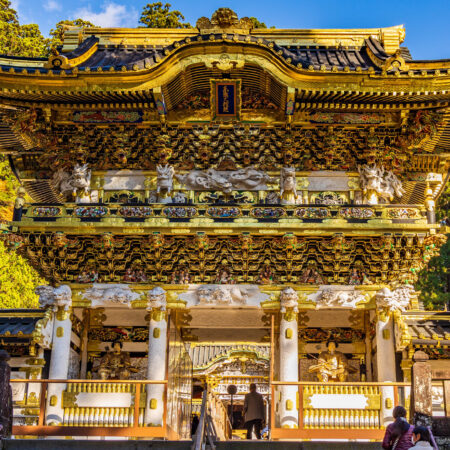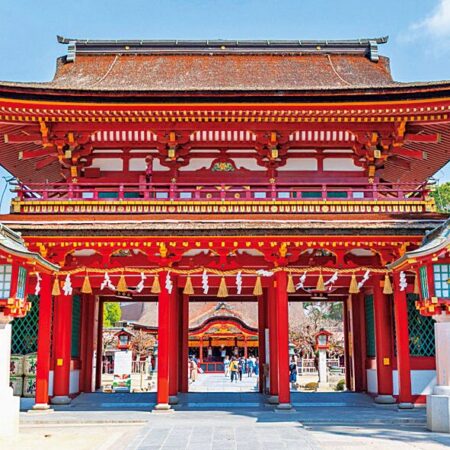Have you ever visited Byodoin Temple’s Phoenix Hall? As a historical building familiar to many from its depiction on the 10 yen coin, seeing it in person is sure to leave you in awe of its splendid architectural beauty and the overall magnificence of the hall reflected in the pond. This luxurious Byodoin Temple’s Phoenix Hall was actually built to bring a ray of hope to a troubled world. Did you know that Byodoin Temple’s Phoenix Hall itself symbolizes something significant? In this article, we will introduce the surprisingly lesser-known history, highlights, and trivia of Byodoin Temple’s Phoenix Hall.
The History of Byodoin Temple’s Phoenix Hall
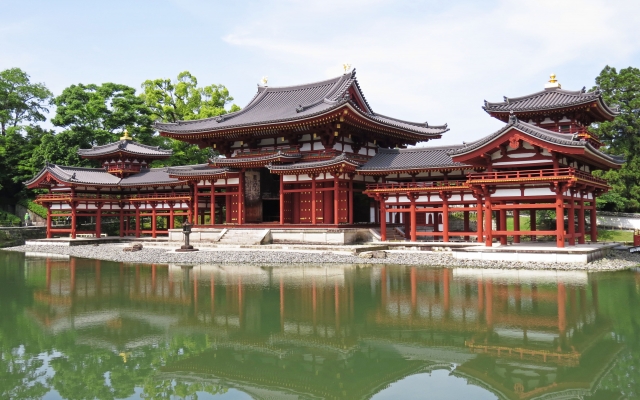
First, let's look at the history. Uji, where Byodoin Temple’s Phoenix Hall is located, is situated in the beautiful suburbs of Kyoto and was known as a retreat for the upper aristocracy during the Heian period. This area housed the villa of Minamoto no Toru, who is said to be the model for Hikaru Genji, and was cherished by successive emperors and aristocrats. After being owned by Fujiwara no Michinaga, this place was called "Uji-dono" and was passed down to his son, Fujiwara no Yorimichi.
When Fujiwara no Yorimichi inherited Uji-dono, society was plagued with great instability. The Mappo thought, which believed that Buddha's teachings would decline 2000 years after his death, was widespread. Around this 2000-year mark, famine, epidemics, rampant theft, and arson in aristocratic residences led to a chaotic world. Frequent direct appeals and armed protests to the imperial court caused distrust, even among the protective guards. In such a world, people believed that chanting Buddha's name was useless, and they sought salvation in the afterlife, hoping to go to the Pure Land of Ultimate Bliss after death.
Amid this troubled era, Fujiwara no Yorimichi decided to transform Uji-dono into a temple, creating a vision of the Pure Land of Ultimate Bliss on earth. This led to the founding of Byodoin Temple and the construction of the Amida Hall, later known as Phoenix Hall. The Amida Hall was a reflection of the Pure Land on earth, dedicated to Amida Nyorai, and designed to provide hope to both the aristocrats and the common people living through difficult times by offering the belief that anyone could be led to the Pure Land by chanting Amida’s name. It was initially called Amida Hall, and during the early Edo period, it came to be known as Phoenix Hall because the shape of the hall with its wings spread resembled a phoenix.
The historical significance of Uji, often ravaged by wars, greatly impacted the fate of Byodoin Temple’s Phoenix Hall. Major conflicts, such as the Battle of Uji Bridge and the Genpei War, posed significant challenges to Byodoin. However, Phoenix Hall endured these trials and has preserved its appearance to this day.
In the Meiji period, there were movements to abolish Buddhism, but Byodoin Temple’s Phoenix Hall was protected through the efforts of the local community. In the 1990s, restoration work using computer graphics was conducted, and in 2001, the Byodoin Museum Hoshokan was opened, providing more opportunities for people to learn about its history and beauty. However, modern urban development has posed new challenges to Byodoin Temple’s Phoenix Hall. The construction of high-rise buildings behind the temple has marred the landscape, leading to the enactment of the "Uji City Landscape Ordinance" to protect its historical value.
The Highlights of Byodoin Temple’s Phoenix Hall
Let's continue by looking at the highlights of Byodoin Temple’s Phoenix Hall. There are various attractions, so let's make sure to check them all out.
Phoenix Hall
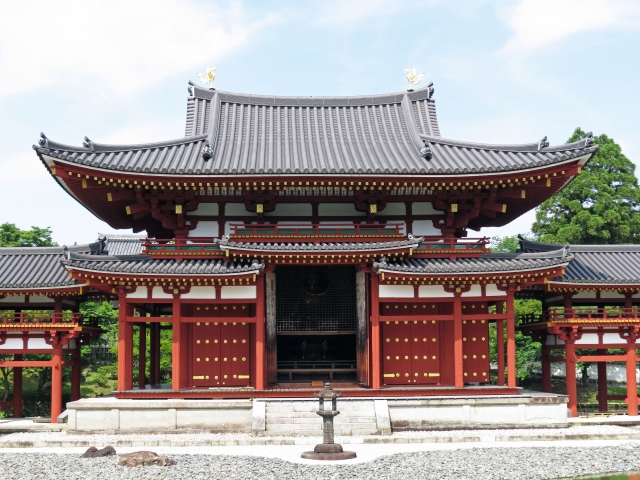
This hall, originally called Amida Hall or Mido, was built in 1053 and came to be known as the Phoenix Hall during the Edo period. It is one of the precious remnants that convey the glorious era of the Fujiwara clan to the present day. The charm of Phoenix Hall lies in its architectural style. Built in the center of a pond, its reflection on the water surface makes it look like a palace of the Pure Land of Ultimate Bliss. On clear days, its fantastical image reflected on the water captivates visitors.
Inside the Phoenix Hall, there is a seated statue of Amida Nyorai enshrined at the center. Based on Pure Land Buddhism, this Amida Nyorai is said to welcome those who seek rebirth. This statue is attributed to Jocho, a renowned sculptor of the late Heian period, and it is the only confirmed work by Jocho that still exists. Additionally, the hall contains beautiful paintings such as the Nine Amidas Welcoming Descent and the Pure Land of Ultimate Bliss. The intricately carved canopy, the pillars adorned with celestial beings and children playing musical instruments, and the vividly colored interior decorations evoke the imagined paradise of the Heian aristocracy.
The phoenix statues on the roof, which gave the hall its name, are currently replicas, with the originals on display at the Byodoin Museum Hoshokan. These phoenix statues are also depicted on the reverse side of the current 10,000 yen note, widely recognized as symbols of the Phoenix Hall.
Kannon Hall
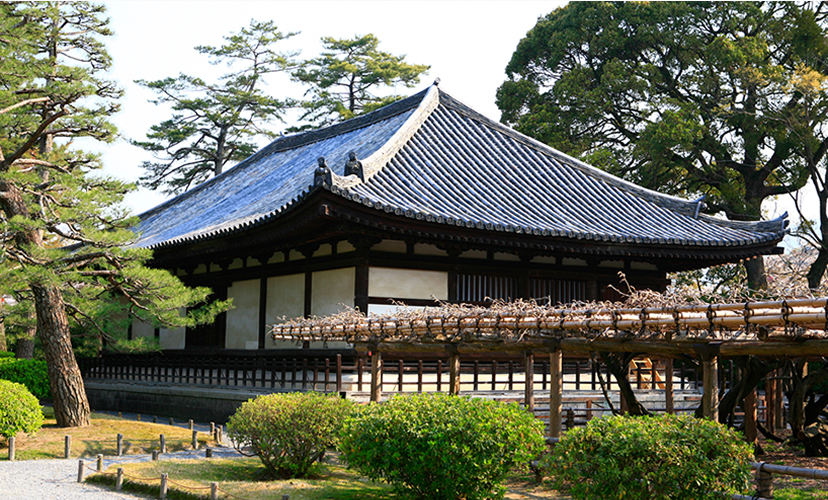
Located within the grounds of Byodoin Temple in Uji, Kannon Hall stands on the site where the original main hall of Byodoin was built during the Heian period. This historic site is now home to Kannon Hall, which was rebuilt in the early Kamakura period and is recognized as an Important Cultural Property. However, the interior of Kannon Hall is not open to the public, leaving its sacred atmosphere to be imagined from the outside.
The name Kannon Hall comes from the principal statue enshrined within it, the Standing Statue of the Eleven-Headed Kannon, created in the late Heian period. This statue symbolizes the compassionate figure of Kannon Bodhisattva and was once the focal point of worship for believers in Kannon Hall. Today, this precious statue has been moved to the Byodoin Museum Hoshokan, allowing more people to appreciate its beauty and historical value up close.
(Image Citation: 平等院公式HP)
Bell Tower
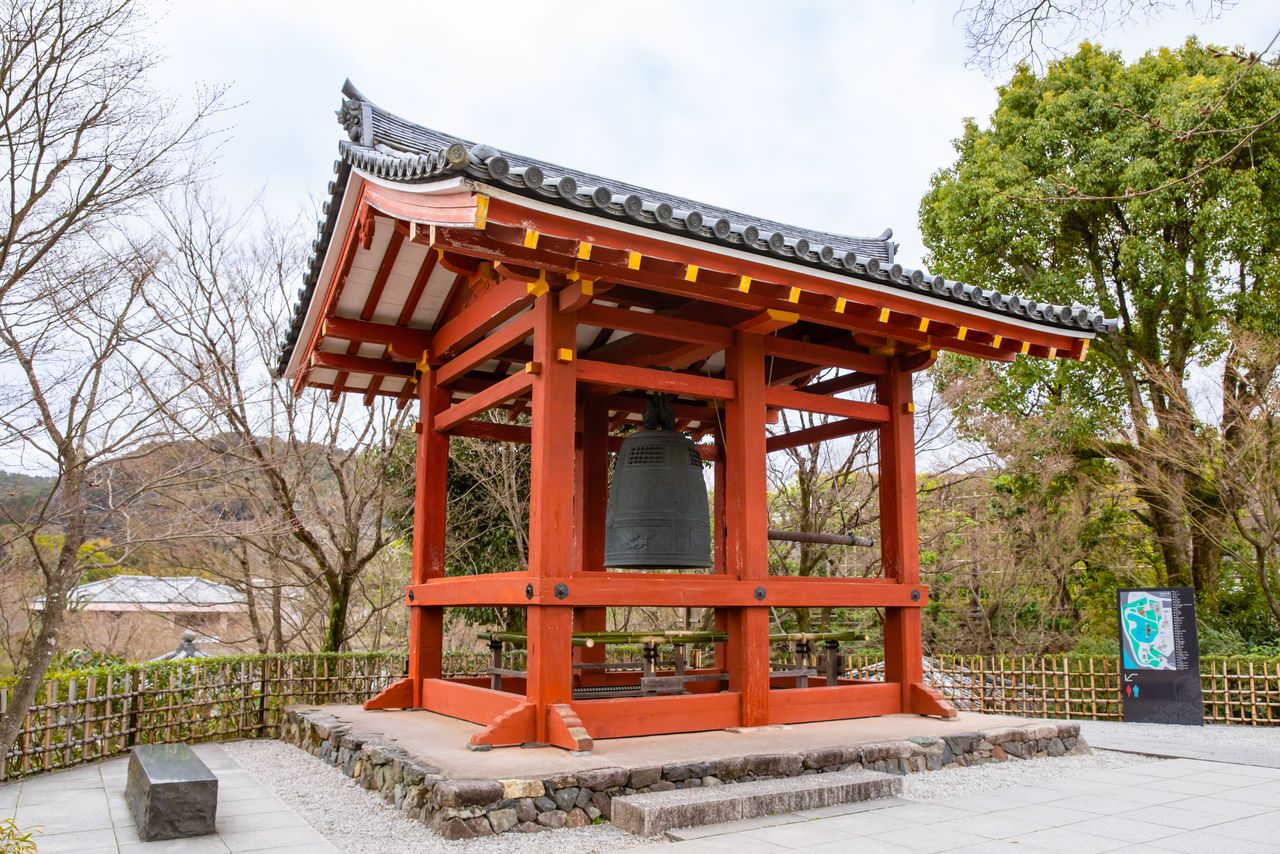
The bell tower standing quietly in the serene garden of Byodoin Temple’s Phoenix Hall continues to captivate visitors with its historical value and beauty. Particularly notable is the bell housed in this tower, designated as a National Treasure in Japan. This bell, or bonshō, stands about 2 meters tall, with an inner diameter at the base of 1.24 meters, and is said to weigh approximately 3 tons.
A bonshō, commonly referred to as a temple bell, is a type of bell used in Buddhist temples. The sound of this bell holds significant meaning for Buddhists and is used during worship and ceremonies. The bonshō at Byodoin has been cherished by many for its beautiful sound throughout its long history. The cultural value of this bonshō was once celebrated by featuring it on a 60-yen postage stamp. For many people who lived during the Showa era, this stamp served as an opportunity to learn about the existence and historical significance of the bonshō.
However, over time, the need arose to consider the preservation of the bonshō. To prevent rust and other damage, the original bell was moved to the Byodoin Museum Hoshokan for storage and display. The bell currently in the bell tower is a faithful replica of the original bonshō. Despite being a replica, it allows visitors to imagine the ancient sound and conveys a piece of history.
(Image Citation: Nippon.com)
Garden
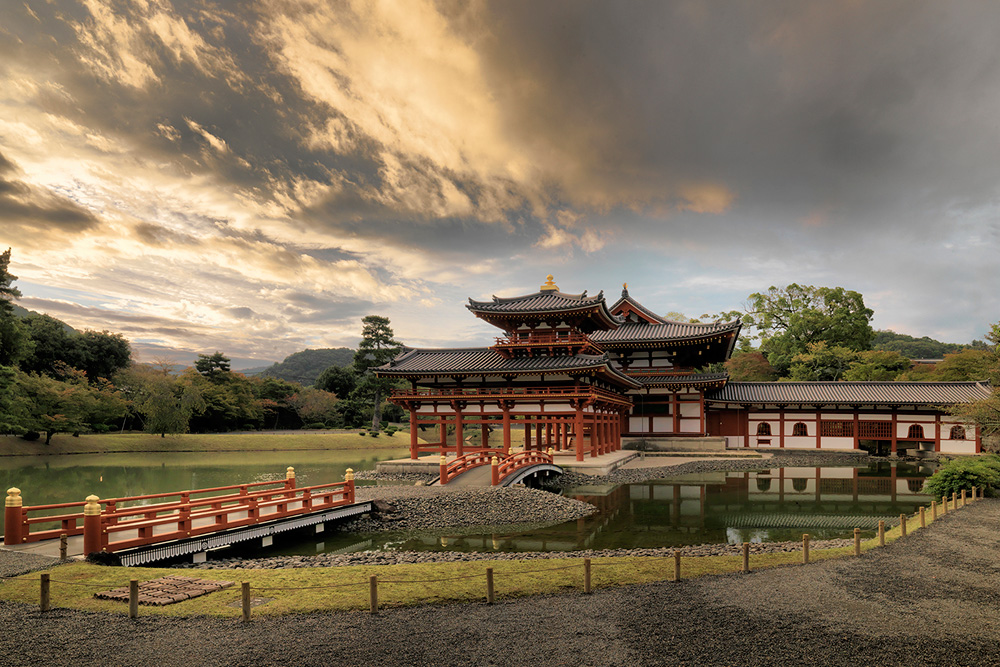
The garden of Byodoin Temple’s Phoenix Hall, designated as a national historic site and scenic beauty in 1922, is a masterpiece of Jodo-style gardens. This garden offers a beautiful landscape that seems to recreate the Pure Land of Ultimate Bliss on earth, conveying the spirituality and beauty of the Heian period to its visitors. The central feature of the garden is the Aji-ike pond, modeled after the sacred pond in the Pure Land. The beauty and significance of this pond have been highly praised since ancient times, as evidenced by the Heian period poet Tachibana no Toshitsuna, who called it "the best of its kind."
The garden's layout aims to represent the Pure Land of Ultimate Bliss on earth, embodying the essence of Jodo thought. The Amida Hall is located on the west bank of the pond. This arrangement reflects the faith of aspiring for rebirth in the Pure Land by crossing the pond from the east bank to worship Amida Nyorai. The sight of the morning sun reflecting on the pond and illuminating Amida Nyorai has deeply moved visitors, as it appears like the Buddha coming from the Pure Land to welcome all beings. Additionally, excavations conducted since 1990 have uncovered a Heian period shuhama (a sandbank with a unique shape). This discovery led to the restoration of the garden to its original appearance, allowing visitors to witness the same scenery that Fujiwara no Yorimichi once saw.
(Image Citation: 平等院公式HP)
Grave of Minamoto no Yorimasa
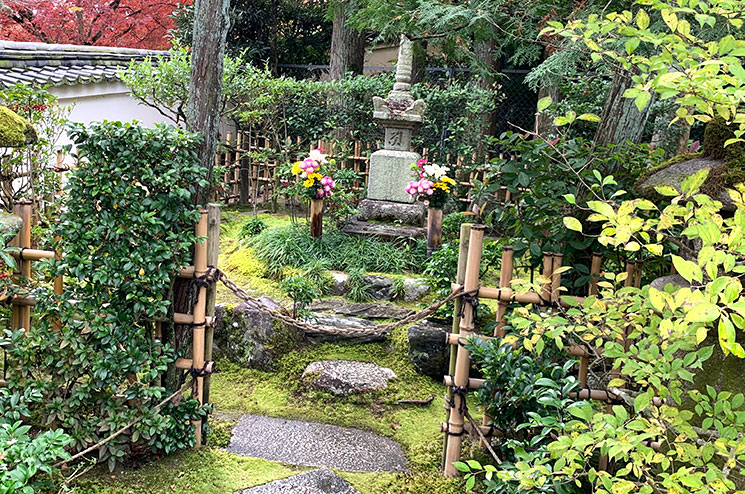
Within the serene grounds of Byodoin Temple’s Phoenix Hall lies the grave of Minamoto no Yorimasa, a renowned warrior and celebrated poet. His grave is known as a hōkyōintō (a type of pagoda), quietly standing in a corner to the left, facing the building of Saisho-in. Minamoto no Yorimasa is known for his military achievements in the Hōgen and Heiji Rebellions and for leaving behind numerous excellent waka poems.
On May 26, 1180, Yorimasa raised an army to overthrow the Taira clan but was repelled by Taira no Tomomori. Following this, he chose to end his life within the grounds of Byodoin Temple, concluding his 76-year life. His final waka poem, left at the time of his death, reflects his character, showcasing both his bravery and literary talent. On the anniversary of his death, May 26, a memorial service called “Kanpaku Yorimasa Memorial” is held to honor his legacy. During this service, a group of monks walks around the temple grounds and chants sutras at the Phoenix Hall to console Yorimasa’s spirit. This ceremony remains an important event, commemorating his contributions to both military and cultural history.
The spot where Yorimasa is believed to have taken his own life is called “Ougi no Shiba” and serves as a significant viewing point for visitors to the Phoenix Hall, conveying its historical significance. This place offers a poignant connection to the dramatic end of Minamoto no Yorimasa and the era in which he lived.
(Image Citation: Amazing Trip)
Phoenix Hall Museum
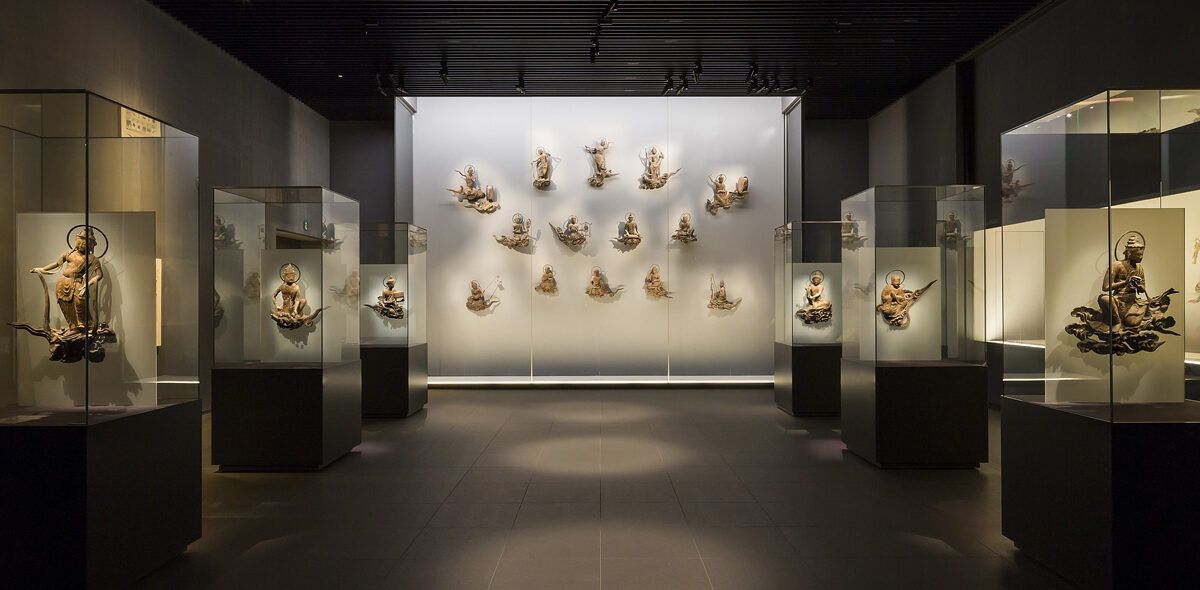
Within the grounds of Byodoin Temple, there is the Phoenix Hall Museum, a place that conveys the spirit of the Pure Land of Ultimate Bliss of Byodoin, a World Heritage site, to the present day. This museum emphasizes harmony with the surrounding natural environment, and much of it is built underground. However, through clever use of natural light and innovative lighting design, a bright and dramatic exhibition space has been created that doesn’t feel like an underground space.
At the Phoenix Hall Museum, precious temple treasures are displayed, including the National Treasure "Brahma Bell," 26 "Bodhisattva Statues on Clouds," and a pair of "Phoenix Statues." Through these cultural assets, visitors can experience the art and spirituality of the Heian period. Additionally, numerous exhibits that tell the history and culture of Byodoin, such as the Important Cultural Property "Standing Statue of the Eleven-Headed Kannon Bodhisattva," deeply move the visitors. Excavated artifacts such as the roof tiles and pottery from the time of Byodoin’s founding are also on display, providing a tangible sense of Byodoin's history. These exhibits are valuable resources for deeply understanding the history of Byodoin and its surrounding region.
One of the museum’s features is the use of the latest digital technology to exhibit a restored video of the interior colors of the Phoenix Hall. Through this video, the vivid colors and decorative beauty of the Phoenix Hall during the Heian period are reproduced using modern technology, conveying its charm to visitors. Additionally, by utilizing one of the largest glass wall cases in Japan, the museum displays each exhibit in a way that highlights its unique characteristics. This innovation allows the historical value and beauty of the cultural assets to be conveyed to a wider audience.
(Image Citation: 京都府ミュージアムフォーラム)
Trivia about Byodoin Temple’s Phoenix Hall
Lastly, let's look at some trivia about Byodoin Temple’s Phoenix Hall.
Does "Byodo" in Byodoin Temple mean it is symmetrical?
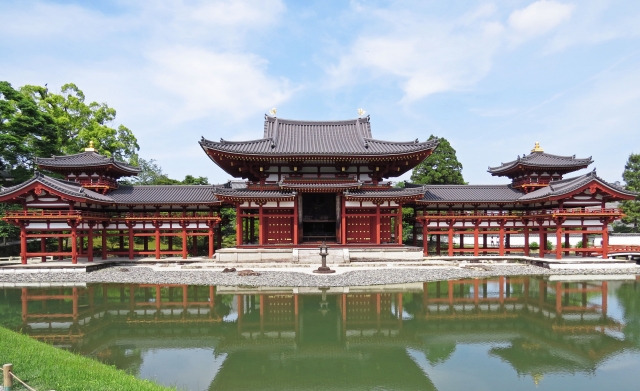
What does "Byodo" in Byodoin Temple’s Phoenix Hall actually mean? Some people might mistakenly think it refers to the symmetry of the building, but it correctly comes from the idea that "the salvation of Buddha is equal for all." It was built to show the Pure Land of Ultimate Bliss to all people during a time when society was in disarray, hence it is called "Byodo" (equal). By the way, Byodoin Temple is a temple of light that represents the equality of Buddha through light.
Why was Byodoin Temple’s Phoenix Hall chosen to be depicted on the 10 yen coin?
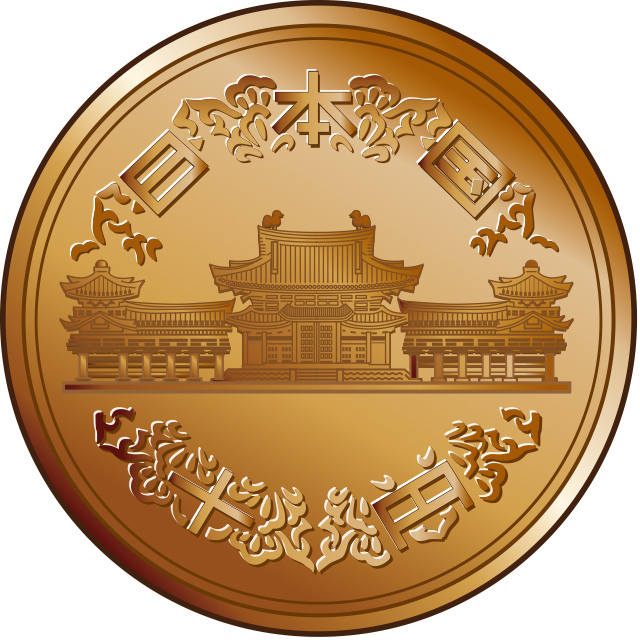
The Phoenix Hall of Byodoin Temple is depicted on the familiar 10 yen coin. The reason it was chosen as the architectural design for the 10 yen coin is that it is a cultural asset representative of Japan, has distinctive architectural features, and is non-denominational. Given its impactful appearance and the fact that the 10 yen coin is used by everyone, they wanted to avoid featuring a building associated with a specific religion. Thus, the Phoenix Hall of Byodoin Temple was selected.
(Image Citation: S-Blog)
Byodoin Temple’s Phoenix Hall does not have stairs and has a low roof that people cannot pass through?
Byodoin Temple’s Phoenix Hall is a two-story structure, but if you look closely, there are no stairs. Moreover, the roof is so low that it’s hard to imagine people passing through. However, there is a reason for this. The Phoenix Hall is a representation of the Pure Land of Ultimate Bliss where Amitabha resides, and it is not a building meant for people to enter. Since it is a building to honor Buddha, practical aspects were not prioritized, and architectural beauty was given precedence. Additionally, there is a theory that Buddha can ascend to the second floor without stairs and is not affected by the physical constraint of the low roof, which explains the absence of stairs and the low roof.
Summary
How was it? This time, we looked at the history, highlights, and trivia of Byodoin Temple’s Phoenix Hall. In a world suffering from continuous wars and famines, the Phoenix Hall was built to show the people, who were feeling hopeless and finding no salvation in Buddhism alone, a vision of the Pure Land of Ultimate Bliss. It was designed to reflect this paradise on earth, with a grand and luxurious structure and the use of a pond to enhance its beauty. Knowing this background can provide a different perspective when you visit Byodoin Temple’s Phoenix Hall in person.
Our website also introduces various other fascinating aspects of Japanese history and culture. If you are interested, we would be delighted if you read our other articles as well!



